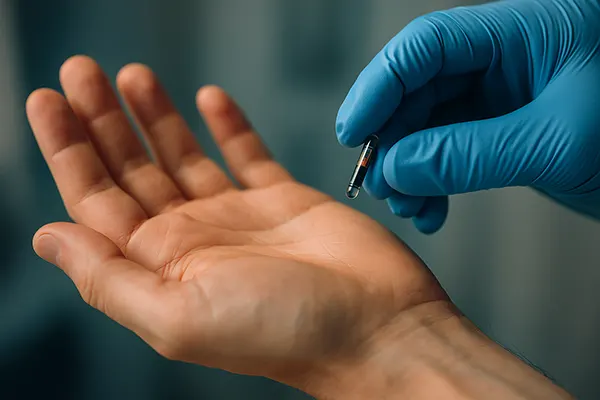Technological advancements in biometric and embedded systems have opened the door to a new frontier in human-machine integration — the use of biological microchips. These devices, often implanted under the skin, can store personal data, medical history, and even act as contactless payment tools. But with growing adoption in countries like Sweden and ongoing ethical debates worldwide, society must now confront the question: Are we truly prepared for embedded identification in 2025?
The Current State of Microchip Implantation
In 2025, subdermal microchip implants have moved beyond experimental trials and niche tech communities. In countries such as Sweden, thousands of people use microchips in everyday life — from accessing buildings to buying metro tickets. Companies like Biohax International and Walletmor offer commercially available solutions, often using near-field communication (NFC) technology.
These chips are typically the size of a grain of rice and are injected between the thumb and index finger. While the implantation procedure is minimally invasive, its implications are far-reaching. These chips can carry identification data, act as access passes, and even hold cryptographic keys for cybersecurity applications.
At the same time, the healthcare sector is exploring medical use cases. Chips can monitor vital signs or store critical patient records, potentially saving lives in emergencies. However, their widespread use remains limited due to concerns over privacy, data protection, and medical ethics.
Public Reception and Market Trends
Public opinion remains divided. While tech enthusiasts and some health professionals welcome the practicality of biochips, concerns over surveillance, coercion, and long-term effects persist. Governments have yet to fully regulate the industry, leaving a grey area in law and consumer rights.
As of mid-2025, consumer markets show cautious growth. Surveys in the EU suggest that around 15–18% of respondents are open to using microchips for health or ID purposes, but less than 5% have taken steps to do so. In contrast, private sector interest is growing. Some employers already experiment with voluntary chip programs for staff access control.
Investment in biometric tech startups has also increased. According to Crunchbase data, global funding in embedded ID technologies surpassed $1.2 billion in the first half of 2025, highlighting the industry’s long-term potential despite short-term resistance.
Technological Infrastructure and Data Security
For embedded identification to succeed, robust digital infrastructure is essential. These chips often rely on wireless protocols like NFC or RFID, which are susceptible to interception and cloning if not properly encrypted. Therefore, secure communication standards and hardware firewalls are vital.
In addition to security, data storage and ownership are critical. Many chip models are passive — they contain static data readable by external devices. Others have limited memory for encrypted dynamic data. However, none are immune to misuse if linked with cloud-based systems vulnerable to cyberattacks.
In 2025, industry leaders are collaborating with cybersecurity firms to introduce decentralised storage models, where chip data is managed by the user via encrypted mobile apps. This trend aims to counter privacy concerns and give users control over their biometric footprint.
Regulatory Landscape and Ethical Challenges
Legislation is still catching up with technology. As of August 2025, only a few EU countries, like Germany and the Netherlands, have specific regulations governing subdermal chips. These laws mostly focus on informed consent, data transparency, and employer limitations.
Globally, regulatory frameworks are inconsistent. In the United States, federal law does not ban biochips, but several states prohibit mandatory implantation. Meanwhile, in Asia and Latin America, national policies are still under development, often influenced by public pressure and privacy campaigns.
Ethicists argue that without clear rules, voluntary adoption may turn into societal pressure — especially in employment, healthcare, and border control. The possibility of discrimination based on willingness to be chipped raises fundamental human rights concerns.

Long-Term Implications and Future Outlook
Looking ahead, embedded identification could transform how humans interact with digital services. If public trust and legal clarity improve, biochips may replace physical IDs, debit cards, and even passports. Integration with blockchain or zero-knowledge proof technologies could provide secure, decentralised identity systems.
However, the path forward depends on societal consensus. Transparent debate, public education, and legislative oversight are crucial. Otherwise, mistrust could stifle innovation and provoke backlash against early adopters and developers alike.
In addition, future biochips may include biometric sensors, programmable firmware, or neural interfaces — pushing boundaries between biology and computing. This could revolutionise medicine, cybersecurity, and even transhumanist research. But it also requires careful governance to prevent misuse.
Societal Readiness and Informed Choice
Ultimately, the question of readiness is not technological but cultural. Are individuals equipped to understand what it means to carry a digital extension of themselves? Are institutions prepared to safeguard such sensitive information?
Education will play a key role. Governments and independent bodies must ensure that citizens are informed about both the potential benefits and the risks. Without accessible, unbiased information, users may fall prey to manipulation or false promises.
In 2025, society stands at a crossroad. Biochips for humans are no longer science fiction. They are here — and whether they become tools of empowerment or surveillance depends on decisions made today.



